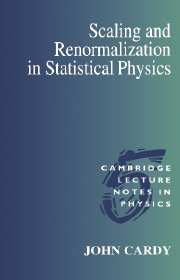Book contents
- Frontmatter
- Dedication
- Contents
- Preface
- 1 Phase transitions in simple Systems
- 2 Mean field theory
- 3 The renormalization group idea
- 4 Phase diagrams and fixed points
- 5 The perturbative renormalization group
- 6 Low dimensional Systems
- 7 Surface critical behaviour
- 8 Random Systems
- 9 Polymer statistics
- 10 Critical dynamics
- 11 Conformal symmetry
- Appendix: Gaussian Integration
- Selected Bibliography
- Index
4 - Phase diagrams and fixed points
Published online by Cambridge University Press: 05 February 2015
- Frontmatter
- Dedication
- Contents
- Preface
- 1 Phase transitions in simple Systems
- 2 Mean field theory
- 3 The renormalization group idea
- 4 Phase diagrams and fixed points
- 5 The perturbative renormalization group
- 6 Low dimensional Systems
- 7 Surface critical behaviour
- 8 Random Systems
- 9 Polymer statistics
- 10 Critical dynamics
- 11 Conformal symmetry
- Appendix: Gaussian Integration
- Selected Bibliography
- Index
Summary
In the previous chapter, the ferromagnetic Ising model provided a simple example of a phase diagram with an associated fixed point structure of the renormalization group flows. There were stable fixed points corresponding to low and high temperature phases, and a critical fixed point controlling the behaviour of critical Ising Systems. However, more realistic systems often have more complicated phase diagrams, and therefore a richer fixed point structure. In this chapter we study some of these examples, and show how, even with a rather qualitative description of renormalization group flows, it is possible to understand phase diagrams from the renormalization group viewpoint. More importantly, when more than one non-trivial fixed point is present, the question arises as to which is the dominant one in a particular region of the phase space. The renormalization group answers this question through the theory of cross-over behaviour. The existence of such phenomena, whereby different fixed points may influence the properties of the same system on different length scales, is totally absent in mean field treatments.
Ising model with vacancies
As a first example, consider a generalisation of the Ising model in which the spin variables s(r) may take the value 0 as well as ±1. This may be viewed as the classical version of a quantum spin-1 magnet, or as a lattice gas of magnetic particles, with |s(r)| playing the role of the occupation number.
- Type
- Chapter
- Information
- Scaling and Renormalization in Statistical Physics , pp. 61 - 82Publisher: Cambridge University PressPrint publication year: 1996

